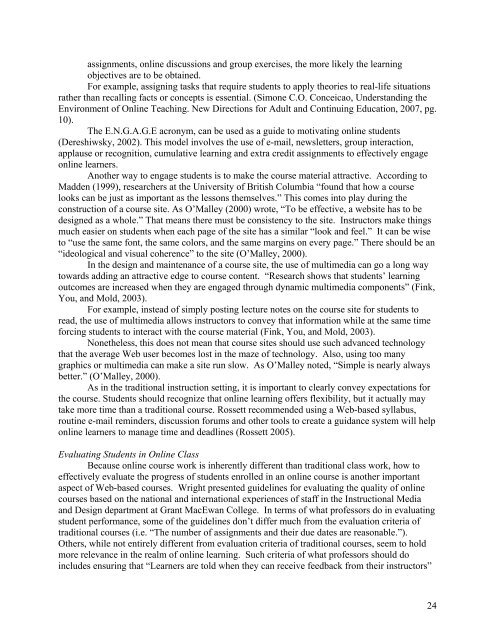2008 PROCEEDINGS - Public Relations Society of America
2008 PROCEEDINGS - Public Relations Society of America
2008 PROCEEDINGS - Public Relations Society of America
Create successful ePaper yourself
Turn your PDF publications into a flip-book with our unique Google optimized e-Paper software.
assignments, online discussions and group exercises, the more likely the learning<br />
objectives are to be obtained.<br />
For example, assigning tasks that require students to apply theories to real-life situations<br />
rather than recalling facts or concepts is essential. (Simone C.O. Conceicao, Understanding the<br />
Environment <strong>of</strong> Online Teaching. New Directions for Adult and Continuing Education, 2007, pg.<br />
10).<br />
The E.N.G.A.G.E acronym, can be used as a guide to motivating online students<br />
(Dereshiwsky, 2002). This model involves the use <strong>of</strong> e-mail, newsletters, group interaction,<br />
applause or recognition, cumulative learning and extra credit assignments to effectively engage<br />
online learners.<br />
Another way to engage students is to make the course material attractive. According to<br />
Madden (1999), researchers at the University <strong>of</strong> British Columbia “found that how a course<br />
looks can be just as important as the lessons themselves.” This comes into play during the<br />
construction <strong>of</strong> a course site. As O’Malley (2000) wrote, “To be effective, a website has to be<br />
designed as a whole.” That means there must be consistency to the site. Instructors make things<br />
much easier on students when each page <strong>of</strong> the site has a similar “look and feel.” It can be wise<br />
to “use the same font, the same colors, and the same margins on every page.” There should be an<br />
“ideological and visual coherence” to the site (O’Malley, 2000).<br />
In the design and maintenance <strong>of</strong> a course site, the use <strong>of</strong> multimedia can go a long way<br />
towards adding an attractive edge to course content. “Research shows that students’ learning<br />
outcomes are increased when they are engaged through dynamic multimedia components” (Fink,<br />
You, and Mold, 2003).<br />
For example, instead <strong>of</strong> simply posting lecture notes on the course site for students to<br />
read, the use <strong>of</strong> multimedia allows instructors to convey that information while at the same time<br />
forcing students to interact with the course material (Fink, You, and Mold, 2003).<br />
Nonetheless, this does not mean that course sites should use such advanced technology<br />
that the average Web user becomes lost in the maze <strong>of</strong> technology. Also, using too many<br />
graphics or multimedia can make a site run slow. As O’Malley noted, “Simple is nearly always<br />
better.” (O’Malley, 2000).<br />
As in the traditional instruction setting, it is important to clearly convey expectations for<br />
the course. Students should recognize that online learning <strong>of</strong>fers flexibility, but it actually may<br />
take more time than a traditional course. Rossett recommended using a Web-based syllabus,<br />
routine e-mail reminders, discussion forums and other tools to create a guidance system will help<br />
online learners to manage time and deadlines (Rossett 2005).<br />
Evaluating Students in Online Class<br />
Because online course work is inherently different than traditional class work, how to<br />
effectively evaluate the progress <strong>of</strong> students enrolled in an online course is another important<br />
aspect <strong>of</strong> Web-based courses. Wright presented guidelines for evaluating the quality <strong>of</strong> online<br />
courses based on the national and international experiences <strong>of</strong> staff in the Instructional Media<br />
and Design department at Grant MacEwan College. In terms <strong>of</strong> what pr<strong>of</strong>essors do in evaluating<br />
student performance, some <strong>of</strong> the guidelines don’t differ much from the evaluation criteria <strong>of</strong><br />
traditional courses (i.e. “The number <strong>of</strong> assignments and their due dates are reasonable.”).<br />
Others, while not entirely different from evaluation criteria <strong>of</strong> traditional courses, seem to hold<br />
more relevance in the realm <strong>of</strong> online learning. Such criteria <strong>of</strong> what pr<strong>of</strong>essors should do<br />
includes ensuring that “Learners are told when they can receive feedback from their instructors”<br />
24
















